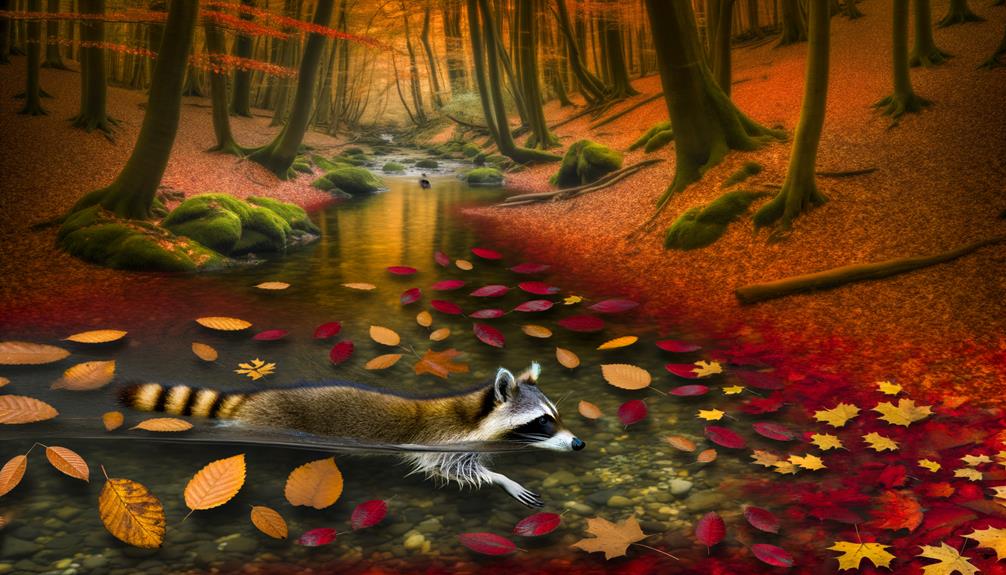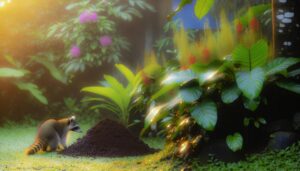Do Raccoons Like to Swim?
Raccoons exhibit proficient swimming capabilities, facilitated by strong limbs, dexterous paws, and a dense, buoyant fur coat. They are frequently observed swimming across ponds, rivers, and streams, signaling a natural prowess in aquatic environments.
Ecological studies underscore their adaptability and resourcefulness in utilizing water for foraging and evading predators. Proximity to water bodies enhances their survival, offering abundant food resources, natural protection, and opportunities for escape from threats.
Seasonal variations influence their swimming activities, with increased aquatic behavior in warmer months and decreased frequency in colder periods. To explore more about raccoons' swimming habits, additional insights are available.

Key Takeaways
- Raccoons are proficient swimmers, often navigating ponds, rivers, and streams.
- They have strong limbs and dexterous paws aiding in swimming.
- Their dense fur provides buoyancy and insulation in water.
- Swimming is part of their daily survival strategies, especially for foraging.
- Seasonal behaviors influence their swimming activity, with more swimming in warmer months.
Physical Adaptations

Equipped with dexterous front paws and a dense, water-resistant coat, raccoons exhibit several physical adaptations that facilitate their swimming capabilities. Their highly agile front paws allow them to grasp and manipulate objects, aiding in propulsion through water.
The dense fur coat, featuring a unique underlayer that traps air, provides buoyancy and insulation, ensuring thermal regulation in aquatic environments. Additionally, raccoons possess a robust musculature that supports sustained swimming, enabling them to traverse various water bodies efficiently.
Their relatively small size and flexible body further enhance maneuverability, allowing them to navigate through narrow or obstructed waterways. Collectively, these adaptations underscore the raccoon's evolutionary alignment with aquatic environments, enhancing their survival and foraging efficiency in diverse ecosystems.
Natural Habitat
While their physical adaptations enhance their swimming capabilities, raccoons are typically found in diverse natural habitats that offer both terrestrial and aquatic resources. These environments include deciduous and mixed forests, marshes, and urban areas near water bodies such as rivers, lakes, and streams.
The presence of water sources is critical, as raccoons rely on them for food procurement and hydration. Additionally, raccoons are highly adaptable and often inhabit areas with abundant vegetation that provides shelter and foraging opportunities. Their omnivorous diet necessitates access to a variety of food sources, including aquatic organisms, plants, and small animals.
Consequently, raccoons are commonly observed in areas where terrestrial and aquatic ecosystems intersect, maximizing their survival and reproductive success.
Swimming Techniques

Raccoons employ a combination of dog-paddle strokes and coordinated limb movements to navigate through water with efficiency and agility. Their robust physical structure, including strong limbs and partially webbed feet, facilitates effective propulsion and maneuverability.
The alternating motion of their front and hind limbs allows for a stable and balanced swimming technique. Additionally, raccoons have a dense fur coat that provides buoyancy and insulates against cold water temperatures.
This dual capability in both terrestrial and aquatic environments underscores their adaptability. Their swimming endurance is notable, enabling them to cross streams, lakes, and other water bodies as needed.
Hunting and Foraging
Utilizing their keen sense of touch and dexterous forepaws, raccoons exhibit remarkable skill in hunting and foraging for a diverse array of food sources. These omnivorous mammals explore various habitats, including forests, urban areas, and wetlands, to obtain their sustenance. Their diet encompasses both plant and animal matter, reflecting their adaptability and opportunistic nature. Raccoons are known to forage for fruits, nuts, insects, and small vertebrates. Additionally, their ability to manipulate objects allows them to open containers, access bird nests, and even catch aquatic prey. The following table highlights common food sources and their respective habitats:
| Food Source | Typical Habitat |
|---|---|
| Fruits and Nuts | Forests, Urban Areas |
| Insects | Wetlands, Gardens |
| Small Vertebrates | Forests, Urban Areas |
Seasonal Behavior

Raccoons exhibit distinct seasonal behaviors that influence their swimming activities. In winter, their swimming habits decrease due to lower temperatures and potential scarcity of open water sources. Summer sees an increase in aquatic activity as they seek to cool off and find food.
During spring and fall, raccoons display shifting behaviors characterized by variable swimming patterns influenced by changing environmental conditions and resource availability.
Winter Swimming Habits
During the winter months, the swimming habits of raccoons exhibit notable changes influenced by environmental conditions and their physiological needs.
Raccoons, being semi-aquatic mammals, generally reduce their aquatic activities during colder periods. The primary factors include reduced water temperatures and the potential for ice formation on bodies of water, which can pose risks such as hypothermia and limited access to aquatic food sources.
Additionally, raccoons enter a state of torpor, a form of light hibernation, to conserve energy and body heat. This physiological adaptation results in decreased overall activity, including swimming.
Consequently, raccoons rely more on terrestrial hunting and foraging during winter, minimizing their exposure to cold water and conserving essential energy reserves.
Summer Activity Patterns
In the summer months, how do the elevated temperatures and plentiful food sources impact the swimming behavior and overall activity of raccoons? As temperatures rise, raccoons demonstrate heightened nocturnal activity, often participating in swimming to cool down. The abundance of food, such as fish, frogs, and aquatic insects, near water bodies also promotes this behavior. Their thick fur, although water-resistant, can lead to overheating, prompting raccoons to swim more frequently.
| Factor | Influence on Behavior |
|---|---|
| Elevated Temperatures | Increased nocturnal activity |
| Plentiful Food | Regular visits to water |
| Dense Fur | Necessity for cooling off |
| Proximity to Water | More swimming incidents |
This seasonal behavior ensures raccoons effectively handle heat stress while taking advantage of abundant food sources, making swimming an essential part of their summer activity patterns.
Spring and Fall Behavior
How do raccoons adapt their activity patterns and swimming behavior to the changing conditions of spring and fall, characterized by fluctuating temperatures and shifting food availability?
In spring, raccoons increase nocturnal foraging as food resources become more abundant. Aquatic environments, teeming with amphibians and insects, attract raccoons, enhancing their swimming activity.
Conversely, in fall, raccoons exhibit hyperphagia to accumulate fat reserves for winter. This behavior involves scavenging along water bodies, where they may swim to access nutritionally rich food like fish and crustaceans.
The fluctuating temperatures of both seasons prompt raccoons to modulate their swimming frequency, balancing energy expenditure with food intake. These adaptive strategies ensure raccoons maintain their energy equilibrium and prepare for the forthcoming harsher conditions of winter.
Playful Activities
Raccoons, known for their inquisitive nature, often engage in a variety of playful activities that include climbing, foraging, and even swimming. These behaviors are important for their physical and cognitive development.
Climbing allows raccoons to navigate their arboreal habitats efficiently, enhancing their agility. Foraging involves complex problem-solving and dexterity, as raccoons manipulate objects and explore their environment for food. Swimming, although not a primary activity, serves as both a recreational and practical skill, enabling them to access aquatic food sources and evade predators.
These activities not only fulfill their survival needs but also exhibit their adaptability and intelligence. Observing these behaviors provides valuable insights into the species' ecological roles and behavioral ecology.
Water Safety

While engaging in swimming activities, it is essential to take into account the water safety measures that raccoons employ to safeguard their well-being. Raccoons exhibit a natural ability to swim and often choose calm, shallow waters to minimize the risk of drowning.
Their dense fur provides buoyancy, aiding in their ability to stay afloat. Additionally, raccoons are adept at using their dexterous front paws to grip onto surfaces, enabling them to pull themselves out of water if necessary. They also tend to avoid swift currents and deep waters, which pose greater risks.
Understanding these behaviors is vital for appreciating how raccoons navigate aquatic environments and maintain their safety while swimming.
Observations and Studies
Numerous observations and studies have documented the natural swimming behavior of raccoons, noting their adeptness in water. These studies often focus on habitats where raccoons are in close proximity to water sources, such as rivers, lakes, and wetlands.
Additionally, recorded instances of raccoons swimming across significant distances further illustrate their capability and adaptability in aquatic environments.
Natural Swimming Behavior
In their natural habitats, raccoons have been frequently observed exhibiting proficient swimming abilities, a behavior that has been well-documented through various ecological studies. These mammals display a notable aptitude for swimming, which includes the ability to navigate water bodies with ease and endurance.
Research indicates that raccoons use their strong limbs and dexterous paws to propel themselves efficiently through water. Observations have recorded raccoons swimming across ponds, rivers, and streams, often as a means to access food sources or to evade predators. Additionally, their dense fur provides buoyancy and insulation, aiding in temperature regulation during aquatic activities.
These findings underscore the raccoon's adaptability and resourcefulness in utilizing water as part of their ecological niche.
Habitat and Water Proximity
Ecological studies have demonstrated that raccoons are often found in habitats that are in close proximity to water sources, such as rivers, lakes, and wetlands. These environments provide raccoons with abundant food resources, including aquatic organisms, and opportunities for foraging.
Research indicates that water-rich habitats support diverse prey availability, which is pivotal for raccoons' omnivorous diet. Additionally, water bodies offer raccoons natural protection and a means of escape from predators. Studies have observed that raccoons are more likely to establish dens and territories near these aquatic environments, suggesting a strong ecological preference.
This proximity to water enhances their survival by facilitating access to food and safety, illustrating the importance of aquatic habitats in their ecological niche.
Recorded Swimming Instances
Field observations and scientific studies have documented various instances of raccoons engaging in swimming behaviors, highlighting their adeptness and comfort in aquatic environments. Researchers have recorded raccoons swimming across rivers, lakes, and even coastal areas to forage for food or evade predators.
For instance, a study published in the Journal of Mammalogy noted raccoons' frequent use of water bodies in their habitat, often swimming considerable distances. Additionally, nighttime camera traps have captured raccoons wading and swimming in search of crayfish and other aquatic prey.
These observations confirm that raccoons are not only capable swimmers but also utilize their swimming skills as a natural part of their daily survival strategies. This adaptability underscores their ecological versatility.
Conclusion
To sum up, raccoons display noteworthy physical adaptations and behaviors that enable their interaction with aquatic environments. Their swimming methods, coupled with a natural habitat frequently close to water sources, highlight their skill in water-based activities.
Research shows that raccoons participate in hunting, foraging, and playful activities in water, especially during warmer seasons. These behaviors, similar to those observed in amphibious animals, demonstrate an evolutionary advantage in their ecological niche.
Grasping these dynamics is essential for understanding their overall ecological impact.






